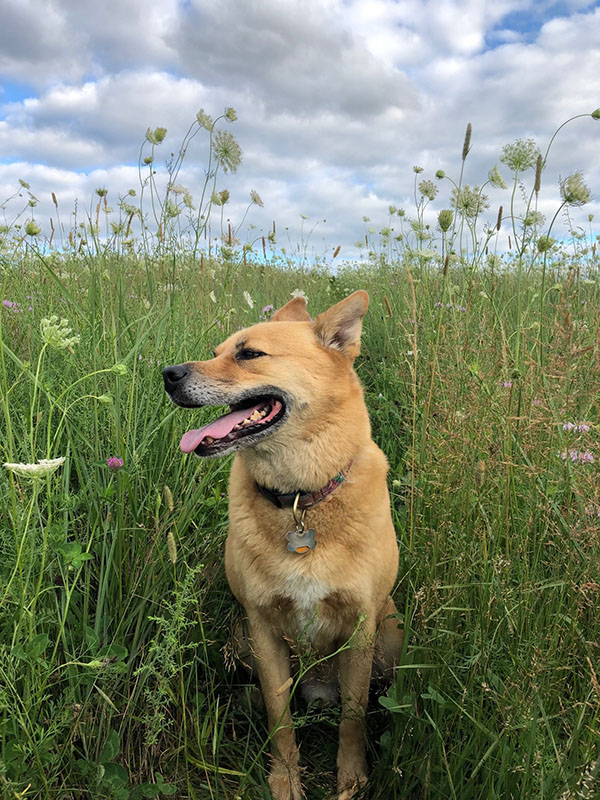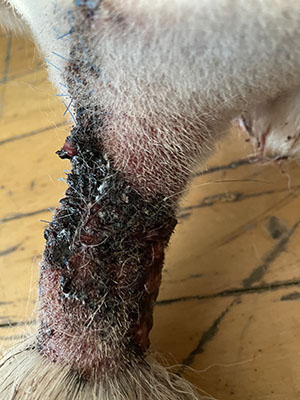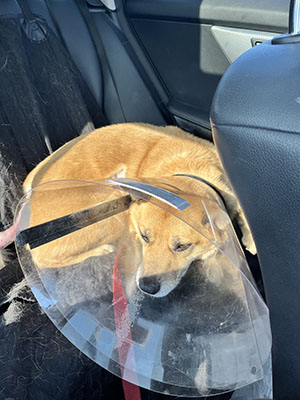"There's a significant chance he'll lose his tail today."
Five days after what should have been a routine cyst removal, our dog Doge lay sedated on an operating table at VEG emergency hospital, fighting a severe infection that could lead to sepsis. Our floors at home had discharge and blood on them.
This is the story of how Duke Animal Hospital—a veterinary practice with over $10 million in annual revenue—turned a simple procedure into a nightmare that nearly cost our dog his tail, and possibly his life.
The Dog Who Rarely Barks
Doge is a Carolina Dog, also known as an American Dingo—a rare breed with ancient roots. Like most Carolina Dogs, he rarely barks, choosing instead to communicate through gentle nudges and expressive eyes. He's timid around strangers, awkwardly friendly with those he trusts, and remarkably intelligent. These dogs are known for their loyalty and resilience, traits that would serve Doge well in the days to come.
In August 2022, we noticed a small sebaceous cyst on his upper tail—about half an inch in diameter. Nothing urgent, but something that needed attention. Duke Animal Hospital came recommended, and their facility on North Ashland seemed professional enough.
The initial examination on August 27th seemed routine. They suggested removing the cyst and recommended a teeth cleaning while he'd be under anesthesia. Standard stuff. We scheduled the surgery for September 13th.
First red flag: They charged us twice for that initial exam. We only caught it later when reviewing our credit card statement and had to call for a refund.
September 13th: When Small Details Matter
The morning of surgery should have been straightforward. Drop off Doge, pick him up later. But small things started going wrong immediately.
The veterinary technician kept calling Doge "she" and using the wrong name, despite multiple corrections. It seems minor, but when someone's about to operate on your pet, you want them paying attention to details. Then, just before taking him back, they asked, "Where exactly is the lump again?"
Hadn't they examined him? Didn't they have notes?
They also tried to charge us $320 for a biopsy we had explicitly declined. We had to show them their own previous quote to get it removed from the bill.
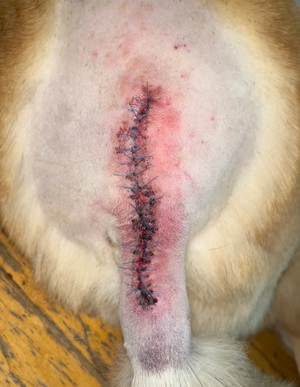
When we picked Doge up that afternoon, we were shocked. The tiny cyst had required a 4-inch incision along the top of his tail. We counted 22 sutures. Twenty-two.
"Everything went normally," they said, handing us a cone that was clearly used and too large (another $30). "Don't let him lick it. See you in two weeks for suture removal."
That was it. No warning about potential complications. No detailed aftercare instructions. No mention of what "abnormal" might look like.
The Longest Week
Day 1: Wednesday, September 14th
Doge's whimpering started that first night. The Carprofen they'd prescribed—essentially dog ibuprofen—wasn't touching his pain. We spent the night on the floor beside him, listening to hours of crying. When we called Duke the next morning, practically begging for stronger pain medication, they reluctantly prescribed Gabapentin.
For comparison: VEG would later prescribe 30mg of Codeine for his pain—actual pain relief for what was clearly severe trauma.
Day 2: Thursday, September 15th
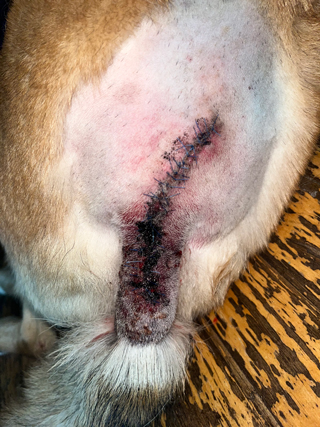
The wound looked wrong. Swollen, angry, weeping. We emailed Duke with photos, waiting hours for a response. When it finally came:
"Dr. Alore looked at the photo and mentioned as long as the tail is not cold to the touch and Doge is doing fine otherwise, Russ could keep an eye on him and if anything changes to give us a call back."
Keep an eye on it. That was their professional medical advice for what was clearly an developing infection.
Day 3: Friday, September 16th
The smell hit us first that morning. Putrid. Like rotting flesh—because that's exactly what it was. The infection had taken hold, and Doge's tail was dying.
We called Duke immediately. Dr. Alore, who had performed the surgery, wasn't available until Monday. They offered us an appointment later that week, or we could come in as an emergency—at full emergency pricing, to see a different vet (Dr. Alore was out).
Based on our description and insistence that this was definitely infected, they prescribed a different antibiotic (Enrofloxacin) for pickup the next morning. Three days post-surgery, and we were diagnosing our own dog's infection over the phone.
Day 4: Saturday, September 17th
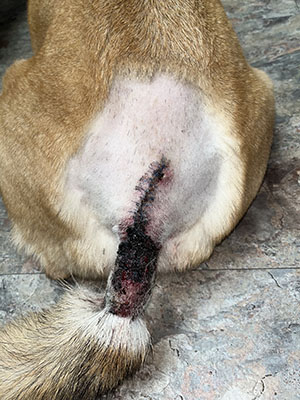
We couldn't wait until Monday. When we arrived to pick up the antibiotics, we insisted someone look at Doge. Dr. Sadler took him to the back for exactly one minute then returned.
"I could do surgery now to open and clean the wound," he said, "or you could wait until Monday to see if the antibiotics help."
We asked for his professional opinion. What would he recommend?
"It can probably wait until Monday."
Note: Duke's records would later claim Dr. Sadler recommended immediate surgery—a complete fabrication we discovered before they locked us out of the patient portal.
Sunday, September 18th: Emergency
By 3 PM Sunday, we couldn't watch Doge suffer any longer. The antibiotics hadn't helped. The smell was overwhelming. Our floors were covered in discharge and blood. We rushed him to VEG (Veterinary Emergency Group) in the South Loop.
The contrast was immediate. The VEG team examined Doge thoroughly, their concern evident. They explained everything clearly, calmly, with genuine care in their voices.
"The wound hasn't healed at all. There's significant infection, possible sepsis. We need to operate immediately. I need you to understand—there's a real chance we might have to amputate his tail."
We were shocked. Couldn't believe we had paid to have our dog put into this danger. The VEG veterinarian, choosing his words carefully, mentioned the original surgery seemed "unusual" for such a small cyst—his professional way of suggesting inexperience or poor technique.
They let us watch the emergency surgery. They explained each step, showed us the infected tissue they were removing, the proper way to clean and dress such a wound. Doge was sedated within hours of arrival, the surgery completed successfully. His tail was saved.
The difference was stark: Duke had been too busy to care. VEG made time to save our dog's tail.
The Recovery and The Call
For the next five days, we returned to VEG daily for wound dressing changes. Each visit, they greeted Doge by name, asked how he was feeling, explained what they were doing. They taught us how to properly care for an open wound, what to watch for, when to worry. Everything Duke should have done from the start.
The emergency surgery cost $1,700—more than the original $1,500 procedure at Duke.
The Phone Call
On September 20th, while Doge was still healing, we scheduled a call with Dr. Angela Duke herself to discuss our experience. We hoped for understanding, perhaps an apology, maybe help with the emergency surgery costs their negligence had caused.
Instead, we got a masterclass in corporate veterinary medicine. Dr. Duke stared coldly into the camera, no emotion on her face as we described Doge's suffering. She interrupted repeatedly, her only concern clearly whether we planned legal action. When we mentioned the emergency surgery costs, she refused any reimbursement, stating Duke had provided appropriate care.
"What exactly are you trying to get at here?" she asked, her tone suggesting we were simply after money.
Within hours of that call, we were locked out of the patient portal.
Why This Story Matters
We took Duke Animal Hospital to court but ultimately dismissed the case. The legal fees would have been five times our financial losses, and the emotional toll of continued interaction with Angela Duke and her lawyers wasn't worth it.
But this story needs to be told.
Duke Animal Hospital isn't your neighborhood vet. With over $10 million in annual revenue and a large staff, it operates like a veterinary factory—prioritizing throughput and profit over patient care.
Had Angela Duke shown even a morsel of humanity—an apology, concern for Doge's wellbeing, acknowledgment that things could have been handled better—we would have moved on. Instead, her cold indifference and defensive posturing convinced us that other pet owners need to know what they might face at Duke.
It's been over two years now. Despite Duke suggesting Doge's age caused complications, he's healthy and thriving. The scar on his tail is barely visible. He still rarely barks, still nudges us gently when he wants attention, still trusts us completely—even after we failed to protect him from that first surgery.
A Call to Veterinary Professionals
If you're a veterinary professional and have thoughts on this case—the surgical approach for a small sebaceous cyst, the post-operative care provided, or the infection management—we welcome your professional opinion. Your insights could help other pet owners make informed decisions about their pets' care.
Please send your thoughts to [email protected]. With your permission, we may add professional perspectives to this account.
⚠️ Graphic Images Below ⚠️
The following section contains detailed photos of the infection progression.
